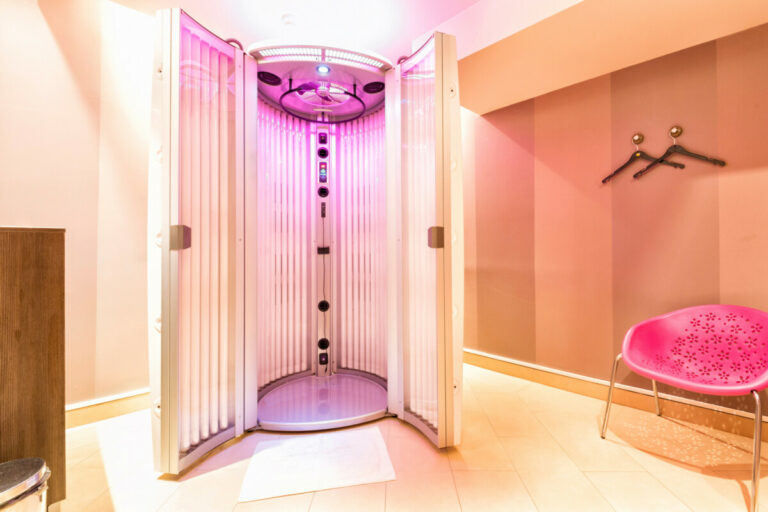Nail Salon Business Plan: 19-Step Comprehensive Guide

If you’re looking to start a nail salon business, having a solid business plan is a crucial first step. A business plan will help you outline your goals, identify your target market, and develop a strategy for success. In this article, we’ll guide you through how to write a nail salon business plan, covering everything from market analysis to financial planning.
1. Executive Summary

As you begin to write your nail salon business plan, it is important to start with an executive summary. This section should provide an overview of your salon and its goals.
Brief Description of The Salon
Your nail salon should be described in detail in this section. This includes the services you offer, the location of your salon, and any unique features that set your salon apart from others. You should also include information about your target market and how you plan to attract and retain customers.
Mission and Vision Statements
Your mission and vision statements should be clear and concise. Your mission statement should describe the purpose of your salon and what you hope to achieve. Your vision statement should describe your long-term goals and aspirations for your salon.
Business Objectives and Goals
In this section, you should outline your business objectives and goals. These should be specific and measurable, and should include both short-term and long-term goals. You should also include a timeline for achieving your goals and the resources you will need to accomplish them.
Overall, your executive summary should be a clear and concise overview of your nail salon business plan. It should provide readers with a clear understanding of your salon’s goals and how you plan to achieve them.
2. Services Offered

As a nail salon owner, it’s important to have a clear understanding of the services you offer. This section will cover the types of manicures and pedicures, specialty treatments, and additional services that you can provide to your clients.
Types of Manicures/Pedicures
Manicures and pedicures are the bread and butter of any nail salon. Here are some of the most popular types of manicures and pedicures that you can offer:
- Basic: This includes a hand or foot soak, nail shaping, cuticle care, massage, and polish application.
- French: This is a classic look that involves a white tip and a natural nail base.
- Gel: This type of manicure or pedicure involves applying a gel polish that is cured under a UV lamp. It’s known for its long-lasting wear and high shine.
- Acrylic: This involves applying a liquid and powder mixture to the nails, which hardens into a durable layer. It’s a popular choice for those who want to add length to their nails.
Specialty Treatments
In addition to basic manicures and pedicures, you can offer specialty treatments to your clients. Here are some examples:
- Paraffin wax treatment: This involves dipping the hands or feet into warm paraffin wax, which helps to moisturize and soften the skin.
- Hot stone massage: This involves using heated stones to massage the hands or feet, which can help to relieve tension and promote relaxation.
- Callus removal: This involves using a special tool to remove calluses from the feet.
Additional Services
To set your nail salon apart from the competition, you can offer additional services that your clients will appreciate. Here are some ideas:
- Nail art: This involves using polish, stickers, or other materials to create intricate designs on the nails.
- Hand and foot treatments: This can include exfoliation, moisturizing masks, and other treatments that help to rejuvenate the skin.
- Waxing: You can offer waxing services for areas such as the eyebrows, upper lip, and legs.
Overall, offering a variety of services can help to attract clients and keep them coming back. By staying up-to-date on the latest trends and techniques, you can ensure that your nail salon is always in demand.
3. Products Offered

As a nail salon business, the products you offer are a crucial aspect of your success. Your customers expect top-quality products that will make their nails look stunning. Here are two sub-sections that will help you organize the products you offer:
Brands of Nail Polishes and Treatments
When selecting the nail polish and treatments you offer, it’s essential to choose high-quality brands that your customers will love. Here are some of the most popular brands to consider:
- OPI
- Essie
- Zoya
- Butter London
- China Glaze
- CND
Each of these brands offers a wide range of colors, finishes, and treatments that will appeal to a broad range of customers. By offering a variety of brands, you can cater to different preferences and ensure that your customers find the perfect product for their needs.
Retail Products for Sale
In addition to nail polishes and treatments, you can also offer retail products for sale. This can include items such as:
- Nail files
- Cuticle oil
- Hand cream
- Nail art supplies
- Nail stickers
By offering retail products, you can increase your revenue and provide your customers with a convenient one-stop-shop for all their nail care needs.
When selecting retail products, make sure to choose high-quality items that your customers will love. You can also consider offering exclusive products that are not available elsewhere, which can help differentiate your salon from competitors.
In conclusion, by offering a wide range of high-quality products, you can provide your customers with an exceptional nail salon experience. Consider the brands of nail polishes and treatments you offer, as well as the retail products you sell, to ensure that your customers have everything they need to keep their nails looking fabulous.
4. Market Analysis

Target Market Description
Your target market for a nail salon business plan should be clearly defined. You should consider factors such as age, gender, income, and location. Your target market may include women of all ages who are interested in nail care and grooming. You may also target men who are interested in nail care and grooming.
Market Trends in Nail Care Industry
The nail care industry is growing rapidly with new trends emerging every year. Nail art, gel nails, and acrylics are some of the popular trends in the industry. Customers are also looking for eco-friendly and organic nail care products. Keeping up with the latest trends in the industry will help you stay ahead of the competition.
Market Size and Growth Potential
The nail care industry is a multi-billion dollar industry with a huge potential for growth. According to IBISWorld, the industry is expected to grow at an annual rate of 3.2% from 2023 to 2028. The growth is attributed to an increase in disposable income, a growing interest in nail care, and the popularity of nail art.
Competitive Landscape
The nail salon industry is highly competitive with many players in the market. You will be competing with other nail salons, spas, and beauty salons. It is important to differentiate your business from the competition by offering unique services, using high-quality products, and providing excellent customer service. You should also research your competition to understand their strengths and weaknesses.
In conclusion, conducting a thorough market analysis is crucial when writing a nail salon business plan. Understanding your target market, keeping up with industry trends, and analyzing the competitive landscape will help you create a successful business plan.
5. Marketing and Sales Strategy

Branding and Positioning
Your branding and positioning strategy will determine how your nail salon is perceived by potential customers. Consider the following questions:
- What kind of image do you want to project?
- What makes your nail salon unique?
- What are your core values and how can you communicate them to your target audience?
Once you have a clear idea of your brand identity, you can start to develop your positioning strategy. This involves identifying your target market and determining how you can differentiate yourself from your competitors.
Pricing Strategy
Your pricing strategy will depend on a number of factors, including your target market, your location, and the services you offer. Do some research to find out what your competitors are charging and how much customers are willing to pay for nail salon services in your area.
Consider offering different pricing tiers to cater to different budgets. You could also offer package deals or loyalty programs to encourage repeat business.
Promotion and Advertising Strategy
Your promotion and advertising strategy should be tailored to your target market. Consider the following options:
- Advertising in local newspapers or magazines
- Distributing flyers or brochures in your local area
- Offering discounts or promotions to first-time customers
- Hosting events or workshops to showcase your services
Make sure your advertising materials are visually appealing and clearly communicate your brand identity and unique selling points.
Social Media
Social media can be a powerful tool for marketing your nail salon. Consider setting up accounts on platforms like Instagram, Facebook, and Twitter. Share photos of your work, post updates about your services, and engage with your followers to build a loyal customer base.
Distribution Channels
Consider partnering with local businesses to distribute your advertising materials or offer joint promotions. You could also consider offering mobile nail services to reach customers who can’t make it to your salon.
Overall, your marketing and sales strategy should be focused on building brand awareness, attracting new customers, and retaining existing ones. By developing a clear brand identity, pricing strategy, and advertising plan, you can set your nail salon up for success.
6. Management and Organization

Organizational Structure
Your nail salon’s organizational structure will depend on the size of your business and the number of employees you have. You can choose from a flat or hierarchical structure. A flat structure is suitable for a small business with a limited number of employees, while a hierarchical structure is better suited for larger businesses with multiple departments.
Key Personnel and Their Responsibilities
Your nail salon’s success depends on the quality of your employees. You should hire qualified and experienced staff who are passionate about their work. The key personnel in your nail salon should include a manager, nail technicians, and receptionists.
The manager will oversee the daily operations of the salon, including managing staff, handling customer complaints, and ensuring that the salon is clean and presentable. The nail technicians will provide nail services to your customers, including manicures, pedicures, and nail art. The receptionist will handle customer inquiries, schedule appointments, and manage the cash register.
Recruitment and Training Processes
To ensure that your nail salon provides high-quality services, you should have a rigorous recruitment and training process. You should advertise job vacancies on job boards, social media, and your website. You should also conduct interviews to assess the candidate’s skills and experience.
Once you have hired staff, you should provide them with comprehensive training to ensure that they understand your salon’s policies and procedures. You should also provide ongoing training to keep your staff up-to-date with the latest trends and techniques in the nail industry.
In conclusion, having a well-structured management and organization plan is essential for the success of your nail salon. By hiring qualified and experienced staff, providing comprehensive training, and having a clear organizational structure, you can ensure that your salon provides high-quality services to your customers.
7. Safety and Hygiene

Salon Cleanliness Standards
Maintaining a clean and hygienic environment is crucial for a successful nail salon business. You should establish and adhere to strict cleanliness standards to ensure the safety of your customers and employees. Here are some guidelines to follow:
- Clean and disinfect all surfaces, tools, and equipment before and after each use.
- Provide a clean and comfortable waiting area for customers.
- Use disposable items whenever possible, such as nail files, buffers, and flip flops.
- Wash and sanitize towels and linens after each use.
- Ensure that the salon is well-ventilated to prevent the buildup of fumes and odors.
Sterilization and Disinfection Procedures
Sterilization and disinfection are essential for preventing the spread of infections and diseases. Here are some procedures to follow:
- Sterilize all metal tools, such as clippers and scissors, using an autoclave or dry heat sterilizer.
- Disinfect all non-metal tools, such as nail files and buffers, using a hospital-grade disinfectant.
- Use disposable items whenever possible, such as gloves and pedicure liners.
- Dispose of all single-use items immediately after use.
- Maintain a log of all sterilization and disinfection procedures.
Employee Health and Safety Protocols
Ensuring the health and safety of your employees is just as important as ensuring the health and safety of your customers. Here are some protocols to follow:
- Provide training on the proper use of tools and equipment.
- Provide personal protective equipment, such as gloves and masks, to employees.
- Encourage employees to report any injuries or illnesses immediately.
- Ensure that all employees are up-to-date on their vaccinations.
- Provide a clean and safe work environment for employees.
By following these safety and hygiene protocols, you can create a clean and safe environment for your customers and employees.
8. Financial Plan

Revenue Projections
To create a solid financial plan for your nail salon business, you need to start with revenue projections. This will help you estimate how much money your business will generate over a certain period of time. To determine your revenue projections, you need to consider factors such as the number of customers you expect to serve, the services you will offer, and the prices you will charge.
Here is an example of how to calculate your monthly revenue projections:
| Service | Price | Number of Customers | Monthly Revenue |
|---|---|---|---|
| Manicure | $25 | 50 | $1,250 |
| Pedicure | $35 | 30 | $1,050 |
| Nail Art | $10 | 20 | $200 |
| Total | $2,500 |
Expense Estimates
Once you have your revenue projections, you need to estimate your expenses. This will help you determine how much money you need to invest in your business and how much you need to charge for your services to cover your costs. Your expenses may include rent, utilities, supplies, equipment, and employee salaries.
Here is an example of how to calculate your monthly expenses:
| Expense | Cost |
|---|---|
| Rent | $1,500 |
| Utilities | $200 |
| Supplies | $500 |
| Equipment | $300 |
| Employee Salaries | $2,000 |
| Total | $4,500 |
Break-Even Analysis
A break-even analysis will help you determine how many customers you need to serve to cover your expenses. This will help you set realistic goals for your business. To calculate your break-even point, you need to divide your total monthly expenses by your average revenue per customer.
Here is an example of how to calculate your break-even point:
| Total Monthly Expenses | Average Revenue per Customer | Break-Even Point |
|---|---|---|
| $4,500 | $50 | 90 customers |
Profit and Loss Forecast
Finally, you need to create a profit and loss forecast to determine your expected profits and losses. This will help you make informed decisions about your business and adjust your strategy accordingly.
Here is an example of how to calculate your profit and loss forecast:
| Monthly Revenue | Monthly Expenses | Monthly Profit/Loss |
|---|---|---|
| $2,500 | $4,500 | ($2,000) |
Remember, these are just examples, and your revenue projections, expenses, break-even point, and profit and loss forecast will depend on your specific business. Use these tools to create a solid financial plan that will help you achieve your business goals.
9. Funding Request

When it comes to funding your nail salon business, it’s important to have a clear understanding of how much money you need and what you plan to do with it. This section will cover the key details you need to include in your funding request.
Amount of Funding Needed
To determine the amount of funding you need, you should create a detailed budget that includes all of your startup costs and operating expenses for the first year of your business. This should include everything from rent and utilities to supplies and marketing expenses.
Once you have a clear idea of your total costs, you can determine how much funding you need to get your business up and running. Be sure to include a cushion for unexpected expenses or emergencies.
Purpose of The Funds
When requesting funding, it’s important to be clear about what you plan to do with the money. Your funding request should outline the specific ways you plan to use the funds, such as:
- Purchasing equipment and supplies
- Paying for rent and utilities
- Hiring employees
- Marketing and advertising expenses
- Working capital for day-to-day operations
By being specific about how you plan to use the funds, you can help potential investors understand the potential return on investment.
Anticipated Terms and Return on Investment for Investors
When seeking funding, it’s important to be clear about the terms and conditions of the investment, including the expected return on investment (ROI) for your investors. This should include details on:
- The amount of equity or ownership stake being offered
- The expected timeline for repayment or exit
- The anticipated ROI for investors
- Any other terms or conditions of the investment
By being transparent and upfront about these details, you can help build trust with potential investors and increase the likelihood of securing the funding you need to launch your nail salon business.
10. SWOT Analysis

Strengths
In this section, you will list the strengths of your nail salon business. These are the internal factors that give your business an advantage over others. Some examples of strengths could be a highly skilled and experienced staff, a great location, a loyal customer base, or unique services offered.
Weaknesses
In this section, you will list the weaknesses of your nail salon business. These are the internal factors that put your business at a disadvantage compared to others. Some examples of weaknesses could be a lack of marketing or advertising, outdated equipment, high employee turnover, or limited services offered.
Opportunities
In this section, you will list the opportunities available to your nail salon business. These are external factors that can help your business grow and succeed. Some examples of opportunities could be a growing demand for nail services in your area, a new shopping center opening nearby, or a partnership with a local business.
Threats
In this section, you will list the threats to your nail salon business. These are external factors that can negatively impact your business. Some examples of threats could be new competition entering the market, economic downturns, changing consumer preferences, or increased regulations.
Remember to consider both the positive and negative aspects of each factor when conducting your SWOT analysis. Use this information to make informed decisions about how to grow and improve your nail salon business.
11. Legal Structure and Compliance

This is not legal advice. Always consult legal counsel.
Business Entity Type
Choosing the right business entity type is crucial for your nail salon. The most common types of business entities are sole proprietorship, partnership, limited liability company (LLC), and corporation. Each entity type has its own advantages and disadvantages. You should consult with a legal professional to determine which entity type is best for your nail salon.
Licensing and Permit Requirements
Obtaining the necessary licenses and permits is essential for operating a nail salon. You will need to obtain a business license, a sales tax permit, and a cosmetology license. The requirements for these licenses and permits vary by state and locality. You should research your state and local regulations to ensure that you are in compliance.
Compliance with Local Health and Safety Regulations
Maintaining a clean and safe environment for your clients is critical for the success of your nail salon. You will need to comply with local health and safety regulations, including those related to sanitation, ventilation, and fire safety. You should also ensure that your employees are trained in proper sanitation and safety procedures.
To ensure compliance with local health and safety regulations, you should develop a set of policies and procedures for your nail salon. These policies and procedures should cover topics such as cleaning and disinfecting equipment, handling hazardous materials, and responding to emergencies.
In summary, choosing the right business entity type, obtaining the necessary licenses and permits, and complying with local health and safety regulations are essential for the success of your nail salon. By taking these steps, you can help ensure that your nail salon operates legally and safely.
12. Customer Engagement and Retention

Loyalty Programs
One of the most effective ways to keep your customers coming back is through a loyalty program. By offering rewards for repeat business, you can show your customers that you appreciate their patronage. Consider offering a point system where customers can earn points for each visit or purchase, which can then be redeemed for free services or discounts.
To make your loyalty program even more enticing, consider offering bonus points for referrals or for booking appointments during slower times of the day or week. This will encourage your customers to not only come back, but also to bring their friends and family along with them.
Referral Programs
Word-of-mouth is one of the most powerful marketing tools available, so why not harness it to your advantage? By offering a referral program, you can incentivize your current customers to bring in new business.
Consider offering a discount or free service to both the referring customer and the new customer. This will encourage your current customers to spread the word about your salon and bring in new business.
Special Promotions and Offers
Another way to keep your customers engaged is by offering special promotions and offers. Consider offering a discount on a specific service during a slow time of the day or week, or running a limited-time promotion on a popular service.
You can also offer special promotions for holidays or events, such as a Valentine’s Day couples package or a Mother’s Day pampering package. By offering these special promotions, you can keep your customers interested and engaged throughout the year.
Remember, keeping your customers engaged and coming back is key to the success of your nail salon. By offering loyalty programs, referral programs, and special promotions, you can show your customers that you value their business and keep them coming back for more.
13. Sustainability and Social Responsibility

Eco-Friendly Product Choices
When creating your nail salon business plan, it’s important to consider the environmental impact of the products you use. Opt for eco-friendly products that are free from harmful chemicals and toxins. Look for brands that prioritize sustainability and use biodegradable packaging.
Consider offering organic and vegan options for your clients, as these products are often more environmentally friendly. You can also reduce waste by using refillable containers for your products and encouraging clients to bring their own reusable nail files and buffers.
Community Involvement Initiatives
As a business owner, it’s important to give back to your community. Consider partnering with local charities or non-profit organizations to support causes that align with your values. You can also organize fundraising events or donate a portion of your profits to charity.
Another way to get involved in your community is by hosting events or workshops that educate clients about sustainability and social responsibility. This can help raise awareness and encourage others to make more environmentally friendly choices.
Ethical Sourcing and Labor Practices
It’s important to ensure that the products you use are ethically sourced and produced. Look for brands that prioritize fair labor practices and use sustainable materials. You can also consider partnering with local suppliers to reduce your carbon footprint and support small businesses in your community.
When it comes to your own business practices, make sure to prioritize fair labor practices and provide a safe and supportive work environment for your employees. This can help build a positive reputation for your business and attract clients who value social responsibility.
By prioritizing sustainability and social responsibility in your nail salon business plan, you can create a business that not only benefits your clients but also your community and the environment.
14. Growth Strategy

Plans for Expansion
To grow your nail salon business, you may consider expanding to other locations. Before you do so, you need to conduct thorough research to determine the best location for your new salon. You should consider factors such as demographics, competition, and foot traffic. Once you have identified the ideal location, you can start planning the expansion process. This may involve hiring new staff, increasing your inventory, and investing in marketing and advertising.
Partnership and Collaboration Opportunities
Partnering with other businesses can help you grow your customer base and increase revenue. Consider collaborating with complementary businesses, such as hair salons or beauty supply stores. You can offer joint promotions or discounts to attract new customers. You may also consider partnering with local businesses to sponsor events or fundraisers.
Online and E-Commerce Strategies
In today’s digital age, having an online presence is crucial for any business. Consider creating a website for your nail salon and optimizing it for search engines. This will help potential customers find your business when they search for nail salons in your area. You can also use social media platforms, such as Instagram and Facebook, to showcase your services and engage with your customers.
Additionally, you may want to consider offering e-commerce services, such as online booking and gift card sales. This will make it easier for customers to book appointments and purchase gift cards, even when your salon is closed. You can also offer online tutorials or product sales to generate additional revenue.
By implementing these growth strategies, you can take your nail salon business to the next level. Remember to stay focused and committed to your goals, and always prioritize your customers’ satisfaction.
15. Risk Management

Identification of Potential Risks
Before starting your nail salon business, it is important to identify potential risks that may arise. Some of the common risks that you may face include:
- Slip and fall accidents
- Chemical exposure
- Fire hazards
- Theft and burglary
- Employee injuries
- Customer dissatisfaction
Preventative Measures
To minimize the risks and prevent accidents from happening, you can take the following preventative measures:
- Regularly inspect and maintain the salon and equipment
- Train employees on safety procedures and handling of chemicals
- Install fire alarms and extinguishers
- Implement security measures such as cameras and alarms
- Provide excellent customer service to reduce the risk of dissatisfaction
Insurance and Protection Strategies
Even with preventative measures in place, accidents can still happen. It is important to have insurance and protection strategies to cover any unforeseen incidents. Consider the following options:
- Liability insurance to cover slip and fall accidents or chemical exposure
- Property insurance to cover damage or loss of property due to fire or theft
- Workers’ compensation insurance to cover employee injuries
- Security systems to deter theft and burglary
By identifying potential risks, taking preventative measures, and having insurance and protection strategies in place, you can effectively manage risks and protect your nail salon business.
16. Feedback and Continuous Improvement

As you develop your nail salon business plan, it’s important to consider how you will gather feedback from customers and employees, and use that feedback to improve your business over time. Here are some key considerations:
Customer Feedback Mechanisms
To gather feedback from customers, you might consider using surveys, suggestion boxes, or online review platforms. Be sure to ask specific questions that will help you identify areas where you can improve, such as the quality of your services, the cleanliness of your salon, or the friendliness of your staff. You should also make it easy for customers to provide feedback and respond promptly to any concerns they raise.
Employee Feedback Processes
Your employees are a valuable source of feedback, as they can provide insight into the day-to-day operations of your salon. Consider implementing regular check-ins or performance reviews to gather feedback from your staff. You might also create an anonymous feedback mechanism to encourage honest feedback.
Plans for Iterative Improvement Based on Feedback
Once you have gathered feedback from customers and employees, it’s important to create a plan for how you will use that feedback to improve your business. This might involve making changes to your services, updating your marketing strategy, or investing in staff training and development. Be sure to track your progress over time and adjust your plan as needed.
To summarize, gathering feedback from customers and employees and using that feedback to make iterative improvements is essential to the success of your nail salon business. By implementing effective feedback mechanisms and creating a clear plan for improvement, you can ensure that your salon is always meeting the needs of your customers and providing a positive experience for everyone who walks through your doors.
17. Contingency Plan

As with any business, it’s important to have a contingency plan in place to prepare for potential disruptions. Here are some key components to include in your nail salon business plan:
Response to Potential Business Disruptions
Identify potential disruptions that could impact your nail salon business, such as natural disasters, power outages, or unexpected closures. Develop a plan for how you will respond to each scenario, including communication with employees and customers.
Backup Suppliers
Identify backup suppliers for your salon products, such as nail polish, acetone, and other supplies. This will ensure that you can continue to provide services to your customers even if your primary supplier experiences a disruption. Keep a list of backup suppliers and their contact information readily available.
Backup Service Providers
Identify backup service providers, such as electricians, plumbers, and cleaning services. This will ensure that you can quickly address any issues that may arise and minimize disruptions to your business. Keep a list of backup service providers and their contact information readily available.
By including a contingency plan in your nail salon business plan, you can prepare for potential disruptions and ensure that your business continues to operate smoothly. Remember to regularly review and update your contingency plan to ensure that it remains relevant and effective.
18. Exit Strategy

When creating your nail salon business plan, it’s important to consider your exit strategy. This will help you plan for the future and ensure that you have a plan in place if you ever need to sell your business or close it down.
Conditions for Business Sale or Closure
It’s important to establish the conditions that would lead to the sale or closure of your nail salon. This could include factors such as retirement, illness, or changes in the market. Having a clear understanding of these conditions will help you make informed decisions about the future of your business.
Valuation Methods and Potential Buyers
When it comes time to sell your nail salon, you’ll need to determine its value. There are several valuation methods you can use, including the asset-based approach, the income approach, and the market approach. You’ll also need to consider potential buyers, such as competitors or investors.
Succession Planning
If you plan to pass your nail salon on to a family member or employee, it’s important to have a succession plan in place. This will ensure a smooth transition of ownership and help maintain the success of your business. Consider factors such as training, mentoring, and financial planning to ensure a successful transition.
By considering your exit strategy when creating your nail salon business plan, you’ll be better prepared for the future and able to make informed decisions about the future of your business.
19. Appendices

Supplementary Documents
In this section, you should include any additional documents that support your business plan. These documents may include legal contracts, permits, licenses, and insurance policies. You should also include any relevant market research, customer surveys, and competitor analysis reports.
Resumes
In this section, you should include the resumes of all key members of your team. This includes the owner, managers, and any other employees who will be involved in the day-to-day operations of the business. You should highlight the relevant experience, education, and skills of each team member.
Certifications
In this section, you should list any certifications or licenses that you or your team members hold. This may include cosmetology licenses, business licenses, and any other relevant certifications.
Market Research Data
In this section, you should include any market research data that you have collected. This may include information on your target market, customer demographics, and industry trends. You should also include any data on your competitors, such as their pricing strategies and marketing tactics.
Financial Spreadsheet
In this section, you should include a detailed financial spreadsheet that outlines your startup costs, projected revenue, and expenses. This spreadsheet should include a breakdown of all costs, including equipment, supplies, and marketing expenses. It should also include a detailed cash flow analysis and profit and loss statement.
Remember to keep all of your appendices organized and easy to read. Use formatting such as tables, bullet points, and bold text as necessary to make the information clear and easy to understand.
Frequently Asked Questions

What are the key components of a successful nail salon business plan?
To create a successful nail salon business plan, you need to include the following key components:
- Executive summary
- Company overview
- Market analysis
- Services and products offered
- Marketing and sales strategy
- Financial plan
- Management and staffing plan
- SWOT analysis
- Future growth plan
How do you create a financial plan for a nail salon business?
To create a financial plan for a nail salon business, you need to:
- Estimate the startup costs
- Determine the revenue streams
- Estimate the operating expenses
- Determine the break-even point
- Create a cash flow forecast
- Determine the financing needs
- Create a profit and loss statement
- Create a balance sheet
What are some effective marketing strategies for a nail salon?
Some effective marketing strategies for a nail salon are:
- Social media marketing
- Email marketing
- Referral programs
- Loyalty programs
- Special offers and promotions
- Collaborations with other businesses
- Online advertising
What should be included in a nail salon business plan executive summary?
The executive summary of a nail salon business plan should include:
- Business overview
- Mission statement
- Services and products offered
- Target market
- Marketing and sales strategy
- Financial highlights
- Management team and staffing plan
- Future growth plan
How do you conduct market research for a nail salon business?
To conduct market research for a nail salon business, you need to:
- Identify your target market
- Analyze the competition
- Conduct surveys and focus groups
- Analyze industry trends and statistics
- Determine the demand for your services
- Determine the pricing strategy
What are the advantages and disadvantages of owning a nail salon business?
The advantages of owning a nail salon business are:
- High profit margins
- Flexible working hours
- Creative and fun work environment
- Opportunities for growth and expansion
The disadvantages of owning a nail salon business are:
- High competition
- High startup costs
- Seasonal fluctuations in demand
- Staffing and management challenges.





